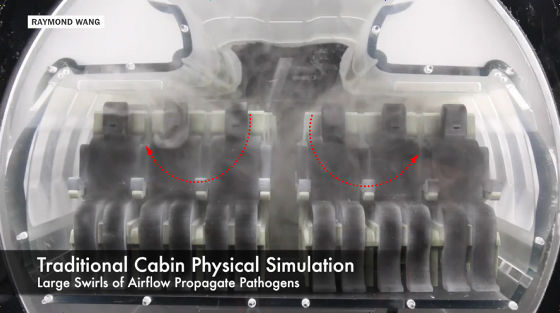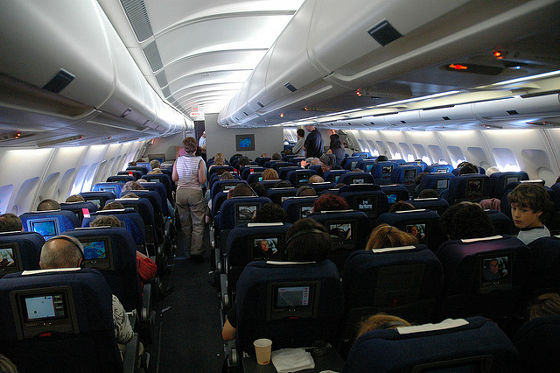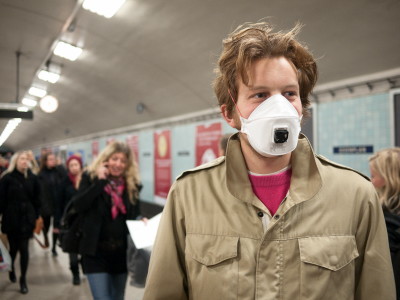A 17-year-old high school student invented an air infection prevention system in a passenger plane and earned a prize of 9 million yen

Needless to say, an airplane flying around the world with a lot of people is very convenient. However, as the cabin (guest room) in flight is a closed space, it is obvious that the possibility of receiving a secondary infection is higher than that of the ground if other people suffer from infectious diseases or the like is. A remarkable countermeasure was not taken against this problem, but a high school student invented a device that prevents bacterial infection just by improving existing cabin ventilation system. When I applied for the contest, I got a prize of about 9 million yen in Japanese yen with winning the award.
Meet the teen who just won $ 75,000 for inventing a system to keep germs from spreading on airplanes - The Washington Post
http://www.washingtonpost.com/news/local/wp/2015/05/15/meet-the-teen-who-just-won-75000-for-inventing-a-system-to-keep-germs-from-spreading-on-airplanes/
What invented this system is Raymond Wang, a high school student living in Canada who is 17 years old. Mr. Wang used this ventilation system as a science contest for high school students hosted by semiconductor maker Intel "Intel International Student Science FairI won the first prize and got a prize of $ 75,000 (about 9 million yen).

Here is a system developed by Mr. One, which uses "air curtain" to prevent splashing of pathogens. You can see smoke flowing inside the aircraft made by imitating the actual airplane cabin and you can see how a completely different air flow is being created by the existing system and the new system devised by Mr. One.
In the existing air conditioning system, you can see how the air sent from the upper part of the seat winds and stagnates in the center of the cabin. Even this air is sucked out from the exhaust port of the floor and discharged to the outside of the machine, but if the pathogen of the infected person gets on the air flow, it is diffused by the vortex to the surrounding passengers Risks exist to exist.

On the other hand, in the air-conditioning system devised by Mr. Wang, air is blown so as to intercept each passenger, thereby falsely creating an "air curtain", so as to efficiently shut out pathogens from surrounding passengers The flow of is designed.

Mr. Wang gave me a chance to devise this system because it became a major issue in West Africa in 2014 and became a global problemEbola fever heat"It was said that it was one case of. Ebola hemorrhagic fever has blood and body fluids as infection sources, so the risk of so-called airborne infection is very low, but for example influenza andSARSIf a passenger with a pathogen such as a bird (Saads) is on board an airplane, the risk of infection spreading to other passengers increases at once.
Mr. Wang, who was interested in this situation, started investigating the ventilation system that the aircraft is equipped with. Then, we found out that existing aircraft makers do not incorporate measures to prevent airborne infection of pathogens so much. According to Mr. Wang, "In the conventional cabin, the two large air vortices are swirling around the anteroposterior direction, and the pathogens are rosed."

ByDoug
So, Mr. Wang invented a space named "Personal Ventilation Zone (Individual Ventilation Zone)" by forcibly creating an air curtain that partitions each passenger, and the pathogen reaches another passenger It is a mechanism to prevent doing. According to Mr. Wang, the system can increase the amount of fresh air reaching each seat by up to 190%, and it is possible to reduce the risk of scattering of pathogens by a factor of 55.
One says the feature of this system is that it can be installed immediately by simply adding simple parts to the existing cabin air conditioning system, according to estimates, the cost per installation is only 1000 dollars (12 Ten thousand yen) very cheap thing. It seems that Mr. Wang is already pending a patent for this air conditioning system.
It was the first victory for Mr. Wan to commemorate, but in reality this is not the first invention for Mr. One. He has developed a power generation system that uses energy from the rain that hits the roof, and an outdoor trash box equipped with a self-cleaning function. In inventing, Mr. Wang says, "It is important first to think of an idea, but the other important thing is how to make the idea known to the world." It is touched on my profile page "about.me" that I have already started my own company "RayCorp".
Raymond Wang | about.me

Although he is one who graduates from high school this fiscal year, he is going to go to university in the future and to learn engineering. Nicole Tyseca, a Canadian national who won second place after Wang at the Intel International Student Science Fair in 2015, is a friend of Mr. Wang. We have developed an inexpensive disposable HIV test kit that can be used in developing countries, and we have a prize of 50,000 dollars (about 6 million yen). She is already starting a company that develops this equipment.
Intel ISEF | Student Science

Related Posts:







